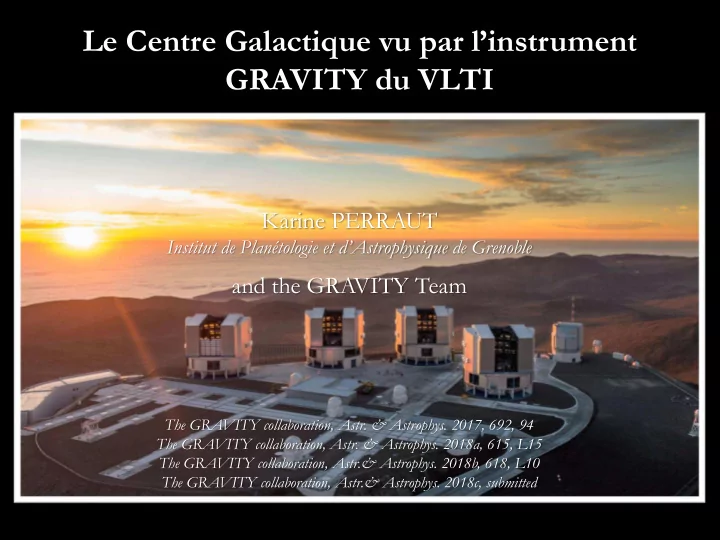

Le Centre Galactique vu par l’instrument GRAVITY du VLTI Karine PERRAUT Institut de Planétologie et d’Astrophysique de Grenoble and the GRAVITY Team The GRAVITY collaboration, Astr. & Astrophys. 2017, 692, 94 The GRAVITY collaboration, Astr. & Astrophys. 2018a, 615, L15 The GRAVITY collaboration, Astr.& Astrophys. 2018b, 618, L10 The GRAVITY collaboration, Astr.& Astrophys. 2018c, submitted
Testing the Massive Black Hole Paradigm from Stellar Orbits in the Galactic Center 8 kpc or 2,5 10 17 km or 26 000 light years M =4.1x10 6 M Image in radio M extended /M < a few 10 -2 M & SgrA* coincident <1 mas [1 mas = 4,86 10 -9 radians] Schödel +02, +03, Ghez et al. +03, +08, Eisenhauer +03, +05, Gillessen +09a,b, +17, Meyer +12, Chatzopoulos +15, Fritz +17, Plewa +16
A Quest of 3 Decades Imaging NACO Spectrometry SHARP @ NTT SINFONI PARSEC l = [2.0 ; 2.5 µm] GRAVITY The ESO Very Large Telescope
The VLT, Very Large Telescope Cerro Paranal, Chile
One of the 8.20-m telescopes of the VLT
GRAVITY has combined 4 telescopes since 2016 Interferometry to synthetize a giant mirror of 140 m Astrometry l = [2.0 ; 2.5 µm] with 2 reference stars IRS16 NW ~ 140 m IRS16 C Angular resolution of 3.5 mas @ 2.2 µm Accuracy ~ a few 10µas
7 institutes over 4 countries ~ 10 M€ and 160 FTE (INSU/CNRS: 1.5 M€ and ~55 FTE) Duration ~ 10 years
Precision Measurements of S2 Orbit with GRAVITY, SINFONI & NACO NACO image March 2018 GRAVITY images May/June 2018 S2 SINFONI spectrum 1 mas = 4,86 10-9 radians GRAVITY collaboration+18, A&A, 615, L15
Routine Faint Milli-arcsec Imaging with GRAVITY April 2017 May 2017 June 2017 22 July 2018 July 2017 August 2017 June/July 2018 May/June 2018 End March 2018 April/May 2018 GRAVITY collaboration+18 50 mas
S2 Passing Peri – 19 May 2018 Motion of S2 seen from day to day June ~120 au 1400 R s 3 1 30 Peri 19 May 27 24 < 50 µas orbit precision 4 2 May 28 26 April Moving at 8000 km/s GRAVITY collaboration+18
Look for G ravitational Redshift in S2’s Orbit Orbit Radial velocities SHARP – 4 mas NACO – 0.5 mas GRAVITY – 30-50 µas GRAVITY collaboration+18a, A&A, 615, L15
Look for Gravitational Redshift in S2’s Orbit Radial velocity difference (km/s)
Gravitational Redshift in S2’s Orbit Light stretched to longer wavelengths by the very strong gravitational field of the black hole. Change in wavelength agrees precisely with that predicted by Einstein’s GR theory. First observation of this deviation in the motion of a star around a supermassive black hole.
Detection of orbital motions near SgrA*s ISCO Baganoff +2001, Genzel et al. 2003, Ghez et al. 2004, Do et al. 2008, Dodds-Eden et al. 2009, 2010, Ponti et al. 2017, Witzel et al. 2018, Broderick & Loeb 2006, Hamaus et al. 2009, Markoff et al. 2001, Yuan et al. 2004, Moscibrodzka et al. 2015, Dexter et al. 2013, Doeleman et al. 2008, Broderick et al. 2011, Johnson et al. 2017
Looking at the flares in the near-infrared In addition to the radio emission, variable X and infrared emission appears as « flares » several times per day during 1-2 hours. The flares originate from transiently heated electrons of the inner accretion and outflow region but their origin is still matter of debate.
Different flare models Material blobs Hot spot on the Statistical fluctuations ejected in a jet closest stable orbit in the accretion flow Consistent with the light Consistent with the Similar to AGN jets curve in the near-infrared and long-term variations the polarization changes of the light curve
On-sky centroid positions 10 µas = 1 R s time time time Statistical fluctuations Jet Hot spot model
Centroid positions measured with GRAVITY Positions recorded with GRAVITY Sgr A* flux recorded with GRAVITY 10 µas = 1 R s (normalized to S2 flux) v orb ~0.3 c GRAVITY measurements Consistent with the hot spot model July 22 nd , 2018
GRAVITY detection of polarization loops Total flux / Flux in linear polarization (normalized to S2 flux) Polarization loop with time Several flare observations are consistent with the same parameters Provide information on inclination (low), magnetic field (poloidal ), … GRAVITY collaboration 2018b, A&A, 618, L10
Conclusion and perspectives - Sgr A*: - The « largest » black hole we can study - A unique lab to study GR - GRAVITY: - Fantastic instrument to do that - Very complementary to other diagnosis - Application to AGN Next steps starting in March 2019: - Look for other stars around SgrA*, closest than S2 - Look at new flares - Look for higher order effects (Schwarzschild precession, Lense-Thirring effects) to better constrain the black hole parameters and physics Mass = 4.144 0.023 10 6 (6 10 -3 precision) Distance = 8174 20 pc (2 10 -3 )
Recommend
More recommend